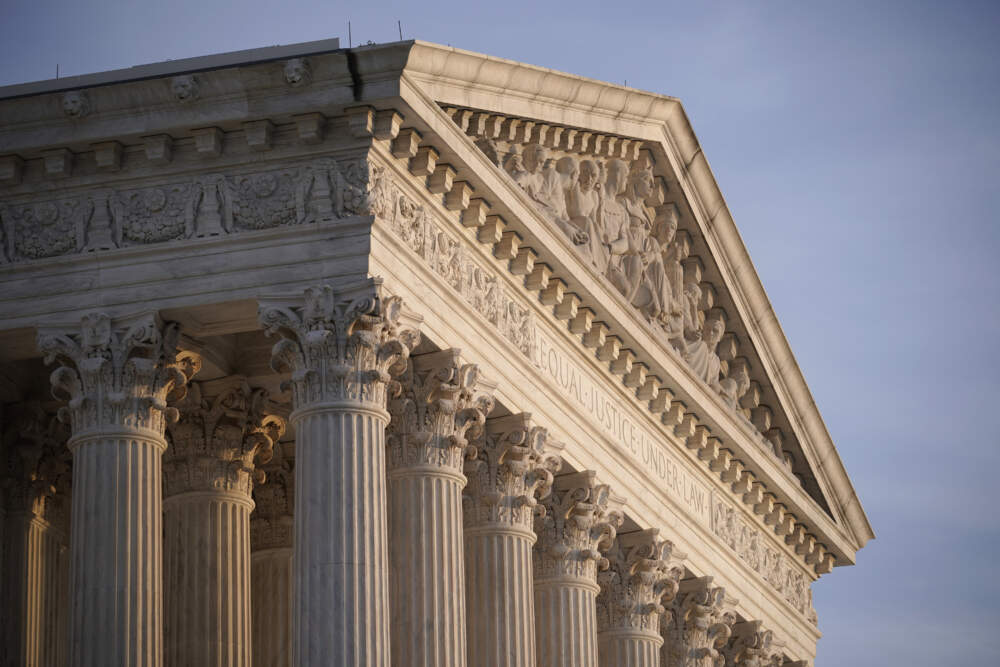Advertisement
Mass. colleges brace for Supreme Court's affirmative action decision

Updated June 29, 2023: The Supreme Court on Thursday ruled that Harvard University and the University of North Carolina violated the 14th Amendment by considering an applicant's race as part of their admissions policies.
"The Court has permitted race-based college admissions only within the confines of narrow restrictions: such admissions programs must comply with strict scrutiny, may never use race as a stereotype or negative, and must—at some point—end," Chief Justice John Roberts wrote in the court's majority opinion.
You can read more about the decision here.
Original post from June 26, 2023:
The U.S. Supreme Court’s decision on the use of affirmative action in higher education could land with an outsized impact in Massachusetts, home to several of the country’s most selective institutions of higher learning.
Justices on the majority-conservative bench sounded skeptical during oral arguments in October about a policy that has survived several legal challenges over the course of decades. That's led many court watchers to say they expect the high court will restrict or end the practice of race-conscious admissions when it issues its ruling.
The two cases under review involve Harvard University and the University of North Carolina at Chapel Hill. But a ruling could have broad repercussions across the state, particularly at the most selective colleges and universities.
Massachusetts is home to 10 colleges that admit just 20% or fewer applicants in an academic year. They are Harvard, Massachusetts Institute of Technology, Amherst College, Williams College, Tufts University, Wellesley College, the Olin College of Engineering, Northeastern University, Boston College and Boston University.
Advertisement
All of those institutions have employed race-conscious admissions as part of efforts to foster diversity on campus, which the Supreme Court in the past has deemed to be a “compelling interest.”
“[S]tudies consistently show that diversity — including racial diversity — improves learning experiences, problem-solving and critical-thinking skills, and interpersonal and leadership skills,” argued an amicus brief submitted last summer by small private schools in defense of Harvard and race-conscious admissions policies.
Tufts, Williams and Wellesley signed on to the brief, in addition to Mount Holyoke College in South Hadley, Hampshire College in Amherst, Smith College in Northampton and Clark University in Worcester.
Between 2010 and 2021, shifts in student demographics were marked across Massachusetts’ 10 most selective schools. In particular, multiracial, Asian and Hispanic enrollment grew notably over the past decade, according to the National Center for Education Statistics.
But the growth in diversity wasn’t evenly distributed among different groups of students of color.
Both Asian and Hispanic student enrollment at the 10 highly selective schools grew by roughly 43%, while the rate for Black students has remained almost flat since 2010, ticking up by just 4%.
Meanwhile, across all 10 institutions, the enrollment of white students from the U.S. fell steadily in the past 11 years: from 45% in 2010 to under 37% by 2021.
International students also occupied a growing number of seats over the 11-year period, though federal data do not include those students' racial and ethnic backgrounds.
There’s a reason for the fierce competition for seats. These highly selective schools offer name recognition, powerful alumni networks and considerable campus resources.
Harvard, the subject of one of the cases brought by the advocacy group Students for Fair Admissions, admits just 3% of applicants in a given year. Of the 1,942 students admitted for the class of 2027, nearly 30% are Asian, 15% are Black and 11% are Hispanic. The college says race is just one of a number of factors it considers.
In its lawsuit, Students for Fair Admissions, a nonprofit led by conservative activist Ed Blum, alleges that Harvard unfairly discriminates against Asian American applicants by holding them to a higher standard and engages in "racial balancing" of incoming students. In 2019, the district court sided with Harvard, setting off an appeal that eventually landed the case before the Supreme Court.
Admissions officers at some colleges fear that a court-mandated ban or restriction on race-conscious admissions will limit access to their schools, rolling back progress toward building more diverse campuses.
“The decision that the court will make will have an impact on the entire community. It will change the landscape of higher education,” said Peaches Valdes, dean of admissions at Wellesley College, the small women’s liberal arts school.
The use of race in admissions
All 10 of the state’s most selective schools have acknowledged that they formally consider applicants’ race and ethnicity as one factor in admissions decisions.
At Wellesley, which admitted just 13% of applicants this spring, Valdes said her team reads every application in context, taking into account “rigor of courses, academic potential and lived experience.” It’s as part of that last facet, Valdes said, that “race and ethnicity come in.”
The college’s goal in assembling its entering classes, Valdes added, is to prepare students “to work in a diverse and global community” after graduation.
In the latest federal data, Wellesley’s undergraduate enrollment was 14% Hispanic and 8% Black — up from 9% and 6%, respectively, in 2010.
Susan Hartley Brisson, director of admissions at Olin College of Engineering in Needham, said the college considers “racial and ethnic representation… in a very holistic kind of way.”
She said the college’s goal since its founding in 1997 has been to create a diverse community, and that it redoubled those efforts after president Gilda Barabino assumed office in 2020.
The small private college of just 310 students saw its Black and Hispanic enrollment climb from 4% in 2010 to 14% in 2021.
Outreach to those communities is especially important, Hartley Brisson argued, given the college’s focus.
“Black and Latino students are historically underrepresented in engineering,” she said.
But that’s beginning to change. Since 2004, Black and Hispanic enrollment at M.I.T. has climbed from 17.5% to 22% — and Olin is trending in the same direction.
Other paths to diversity
Pursuing diversity outside the formal admissions process can be difficult, but selective schools increasingly see it as worth the effort.
At Olin College, Hartley Brisson said admissions officers conduct a lot of travel for recruitment purposes.
“We try to reach out to and visit different communities … where people haven’t heard of us,” she said.
Valdes said Wellesley admissions staff offer “themed presentations” across the country in both urban and rural areas; stage mini-college fairs; and offer a growing number of opportunities for students to learn about the college online in cases where travel is difficult.
Officials at Amherst are trying another strategy. In 2021, the college stepped up financial aid and ended “legacy preferences” — which tend to favor white students — in an effort to level the playing field and foster accessibility without considering the race of applicants.
Nine states currently ban affirmative action. In amicus briefs submitted to the court last year, the public university systems in California and Michigan told the court that they tried to pursue diversity via “race-neutral alternatives” after their state bans.
In California, those strategies include stepped-up recruitment of underrepresented students of color, the suspension of the use of standardized tests and a policy of selecting top performers from all state high schools.
The results, university officials concluded, were disappointing. Even with those alternatives in place, the number of Black and Hispanic students never regained pre-ban levels.
Both Valdes and Hartley Brisson stopped short of speculating how their respective schools would adapt to a ruling that barred the consideration of race in admissions. But both said that, however the court rules, diversity would remain a core institutional priority.
This article was originally published on June 26, 2023.
